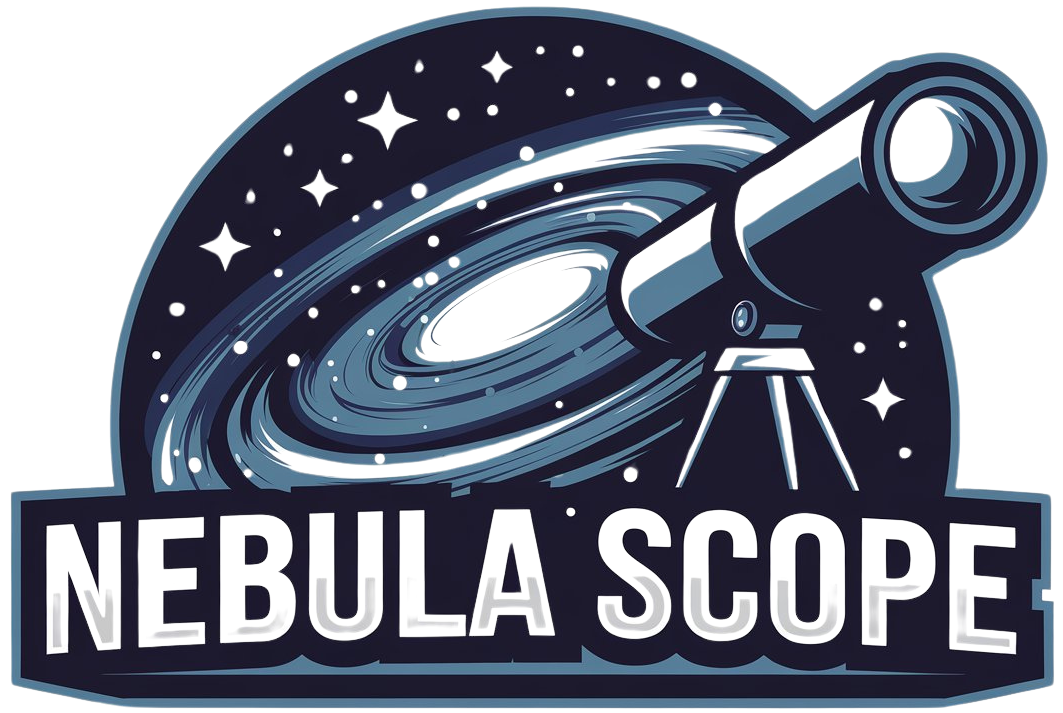The exoplanet K2-18 b can have an ocean of water underneath a hydrogen-rich surroundings, as proven on this artist’s thought. Credit score: Representation: NASA, ESA, CSA, Joseph Olmsted (STScI). Science: Nikku Madhusudhan (IoA)
This previous yr introduced a lot of the sector in combination thru occasions each expected and surprising. April’s extremely awaited overall photo voltaic eclipse extremely joyful tens of millions with the sight of an entire life — even though dodging clouds were given slightly annoying for some. Lower than a month later, the Solar unleashed a large hurricane that lit the skies with dazzling aurorae above locales that infrequently see such attractions.
Additionally with reference to house, scientists discovered the supply of the Moon’s skinny surroundings, NASA regarded for industrial companions to avoid wasting its Mars sample-return challenge, and astronauts checking out Boeing’s Starliner changed into long-term citizens of the World House Station when the craft’s thrusters did not behave as deliberate. Farther afield, new photographs of the Milky Method’s supermassive black hollow hinted it could possess a hidden jet, astronomers came upon the heaviest galactic stellar-mass black hollow, and researchers ramped up the seek for atmospheric options that would possibly sign lifestyles on extrasolar planets.
All of the whilst, the James Webb House Telescope made brand-new discoveries and added to outdated ones, proceeding to turn out that whilst one cosmic query is spoke back, many extra are left in its wake.
10. Exoplanet atmospheres come into focal point
The James Webb House Telescope (JWST) is without doubt one of the maximum robust gear we have now within the seek for liveable planets with heat, temperate atmospheres. However discovering the ones worlds was once by no means going to be simple.
Most likely no unmarried exoplanet has been extra mentioned and debated over the last yr than K2-18 b, a planet within the liveable zone of a crimson dwarf 124 light-years away. At more or less 8.6 occasions Earth’s mass and a pair of.6 occasions its girth, scientists aren’t positive whether or not this can be a rocky super-super-Earth or a miniature model of hydrogen-rich fuel giants like Neptune.
In 2023, researchers the use of JWST reported that K2-18 b’s surroundings contained carbon dioxide and methane. One interpretation of this knowledge is that the planet has a hydrogen-rich surroundings however a rocky floor lined with a world water ocean.
Much more tantalizing, the group reported a imaginable indication of dimethyl sulfide (DMS), a compound that on Earth is produced best through lifestyles — basically phytoplankton. However the sign on K2-18 b was once very tentative, the group famous; despite the fact that showed, it may well be every other chemical mimicking the spectral signature of DMS.
On Would possibly 2, 2024, a group led through researchers from the College of California, Riverside, reported in The Astrophysical Magazine Letters that the putative DMS sign was once a lot more more likely to be led to through methane. Additionally they concluded that distinguishing DMS from methane at that individual wavelength is most likely past JWST’s functions. Alternatively, they discovered it’s nonetheless imaginable that very excessive ranges of DMS may well be known within the mid-infrared; JWST effects from K2-18 b at the ones wavelengths are pending.Days later, every other JWST find out about was once revealed in Nature, reporting for the 1st time sturdy indicators of an environment round an exoplanet this is undoubtedly rocky. Alternatively, that planet, 55 Canrcri e, is infrequently liveable. Orbiting its host celebrity at only one.5 p.c the gap of Earth from the Solar, its dayside temperatures most probably succeed in 4,400 levels Fahrenheit (2,400 levels Celsius).
9. Gaia discovers an historic, heavy black hollow
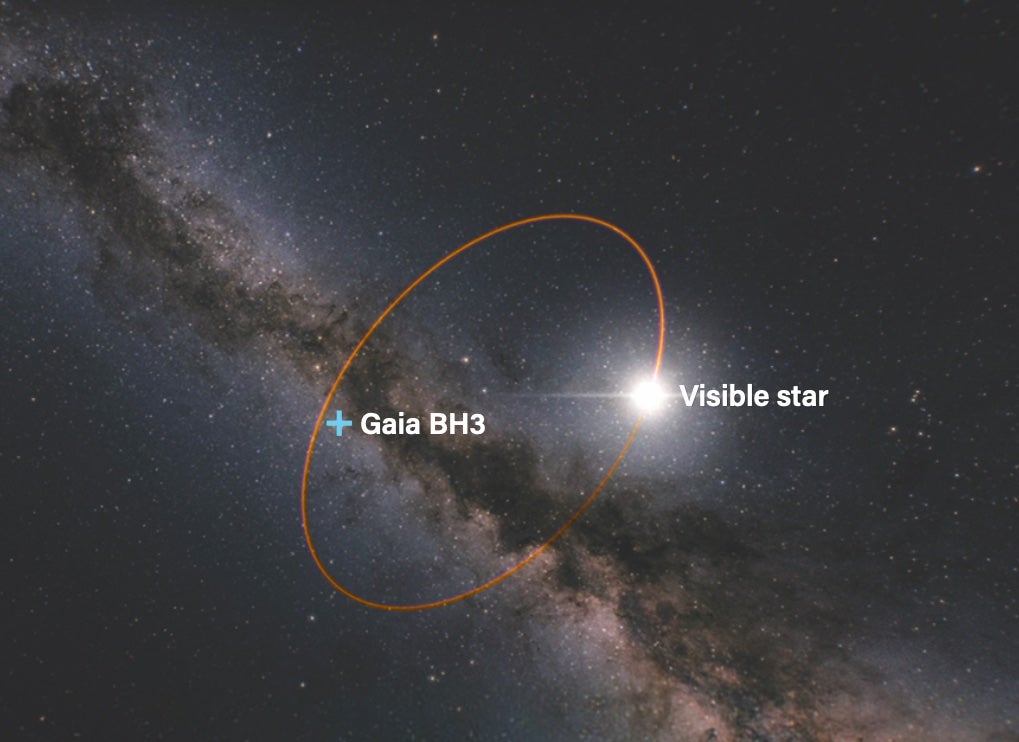 Astronomers known Gaia BH3 (whose place is marked through the go) no longer through its vibrant accretion disk — it doesn’t have one — however through staring at its visual spouse, a large celebrity, orbit an invisible object. Credit score: ESA/Gaia/DPAC – CC BY-SA 3.0 IGO. In response to Gaia Collaboration, P. Panuzzo, et al. 2024
Astronomers known Gaia BH3 (whose place is marked through the go) no longer through its vibrant accretion disk — it doesn’t have one — however through staring at its visual spouse, a large celebrity, orbit an invisible object. Credit score: ESA/Gaia/DPAC – CC BY-SA 3.0 IGO. In response to Gaia Collaboration, P. Panuzzo, et al. 2024
Since 2013, the Gaia satellite tv for pc has been mapping stars all through our Milky Method. Alongside the best way, its records have facilitated a large number of discoveries. Amongst them is Gaia BH3, the heaviest-known stellar-mass black hollow in our galaxy thus far.
Stellar-mass black holes are left when a large celebrity ends its lifestyles as a supernova. They vary from a couple of to 100 occasions the mass of our Solar. Since Cygnus X-1’s discovery as the 1st stellar-mass black hollow, it had additionally reigned ultimate because the Milky Method’s heaviest, at 21 photo voltaic plenty.Now it’s been outdone through a depressing, dormant black hollow just about 4 occasions nearer to Earth.
Gaia BH3 is in a binary device with a celebrity 1,926 light-years away. Astronomers noticed it in initial Gaia records supposed to be launched in 2026 — however the in finding was once so thrilling they couldn’t wait, publishing it Would possibly 27 in Astronomy & Astrophysics.
Gaia BH3 isn’t pulling in subject and doesn’t have a vibrant accretion disk to offer it away. As a substitute, the movement of the visual celebrity printed an invisible spouse weighing 33 photo voltaic plenty. Not anything so huge is also darkish — aside from a black hollow.
“It’s the first time a black hole of this size has ever been observed, with the exception of those detected in distant galaxies by the LIGO-Virgo gravitational observatories,” stated find out about lead writer and Gaia collaboration member Pasquale Panuzzo of CNRS, Observatoire de Paris, France, in a press free up. “This is the kind of discovery you make once in your research life.”
Along with breaking the burden document, Gaia BH3 may be losing mild on how such huge black holes shape. Ageing stars blow away a lot in their mass thru winds, leaving much less subject material to create a heavy black hollow. However stars born previous within the cosmos’ historical past have been extra huge and can have had weaker winds, thus leaving in the back of extra huge black holes.
Backing up that tale is its spouse: an outdated, metal-poor celebrity, which means it has few components heavier than hydrogen or helium. Stars are necessarily steel producers. Each and every era of stars enriches the cosmos, in order that more youthful generations include extra metals at their beginning. Steel-poor stars are subsequently from previous in cosmic time. And in keeping with its movement, the pair most probably as soon as belonged to a globular cluster that has lengthy since been cannibalized through the Milky Method.
All this issues to Gaia BH3 as a relic from the cosmos’ historic previous, hiding in simple sight. Moreover, “this discovery should be also seen as a preliminary teaser for the content of Gaia DR4,” the paper concludes, “which will undoubtedly reveal other binary systems hosting a [black hole].”
8. NASA rethinks Mars Pattern Go back
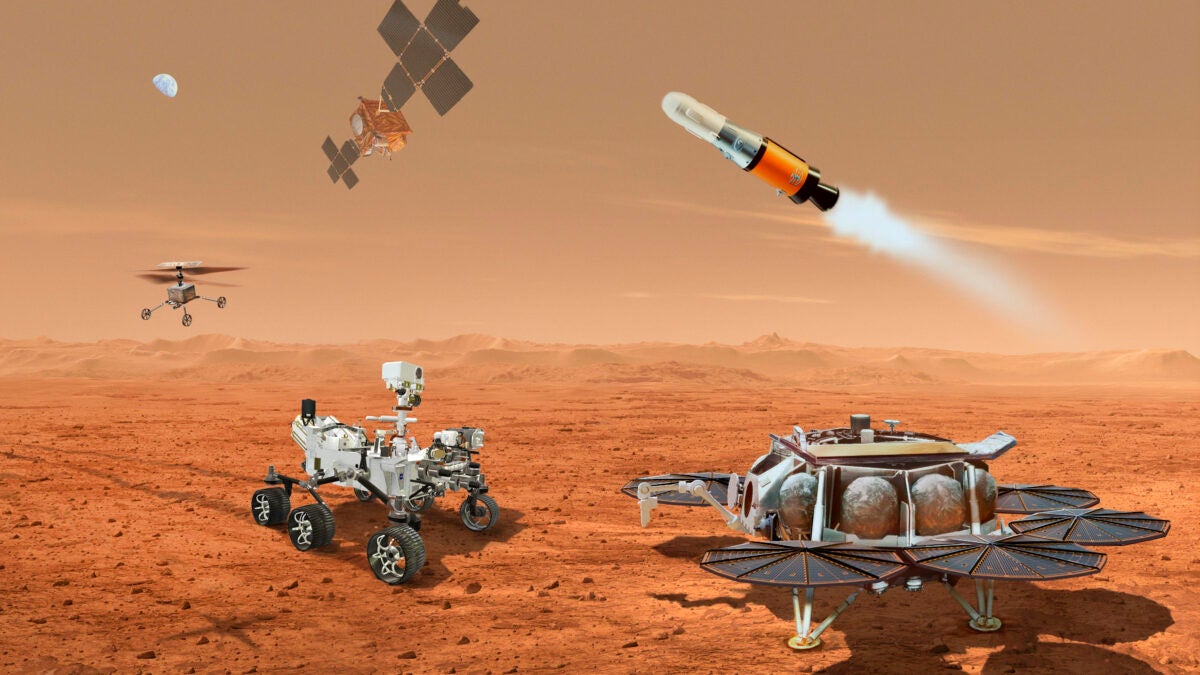 Within the now-postponed NASA-ESA Mars Pattern Go back challenge, the Perseverance rover and helicopter drones would deliver rock samples to a lander, from which an ascent automobile would elevate the samples to a go back orbiter. NASA has since sought assist from business to simplify this scheme. Credit score: NASA/ESA/JPL-Caltech
Within the now-postponed NASA-ESA Mars Pattern Go back challenge, the Perseverance rover and helicopter drones would deliver rock samples to a lander, from which an ascent automobile would elevate the samples to a go back orbiter. NASA has since sought assist from business to simplify this scheme. Credit score: NASA/ESA/JPL-Caltech
The automobile-sized Perseverance rover has spent 4 years on Mars wheeling around the historic lakebed of Jezero Crater, drilling and caching rock samples in order that, for the 1st time ever, martian rock samples will also be returned to Earth for close-up find out about. The samples have been supposed to be retrieved through a suite of joint NASA-Ecu House Company (ESA) missions over the following decade. However plans for the samples’ adventure house are actually crumbling within the face of funds struggles.
The challenge, referred to as Mars Pattern Go back (MSR), firstly referred to as for NASA to ship a lander with an ESA-built rover to fetch the samples. The lander’s ascent level, referred to as the Mars Ascent Car (MAV), would loft the valuable shipment to martian orbit to be captured through a Ecu orbiter, introduced one after the other, that may whisk them again to Earth in 2031.
The complexity of this scheme had already triggered more than one rethinks. In March 2022, NASA officers stated they deliberate to release the MAV and the ESA fetch rover on separate spacecraft to scale back possibility, with go back scheduled for 2033. Then, 4 months later, NASA and ESA stated the fetch rover could be scrapped solely. As a substitute, in 2030, Perseverance — which can then be happening a decade outdated — would ship its personal samples to the retrieval lander. As a backup, the lander would additionally deliver two helicopter drones that would nab the samples and fly them to the MAV.
On the identical time, MSR’s investment was once drying up. In Congress, funds negotiations left NASA with a 2 p.c funds minimize in 2024. MSR was once toughest hit. On Feb. 6, 2024, the Jet Propulsion Laboratory in Pasadena, which has designed, constructed, and operated all of NASA’s Mars rovers, laid off 530 group of workers — round 8 p.c of its body of workers.
On April 15, NASA introduced all the MSR challenge was once on hang and wanted an overhaul. Beneath the prevailing plans, the company estimated, the samples would no longer arrive on Earth till 2040, and it will price as much as $11 billion. Successfully, NASA was once admitting it was once out of cash, out of time, and out of concepts.
To get the rocks again extra cost effectively and temporarily, in June, NASA commissioned research from seven corporations — together with Lockheed Martin, SpaceX, and Blue Beginning — with more than a few ideas and concepts for revising the challenge structure. NASA additionally indicated it’s keen to believe proposals that may go back as few as 10 samples, down from the 30 firstly was hoping for. The research have been due again to NASA in October.
Within the interim, China has introduced plans to release its personal Mars sample-return challenge, Tianwen-3, as early as 2028. Time will inform who can if truth be told pull off the multi-planet effort.
7. Meteorites create the Moon’s surroundings
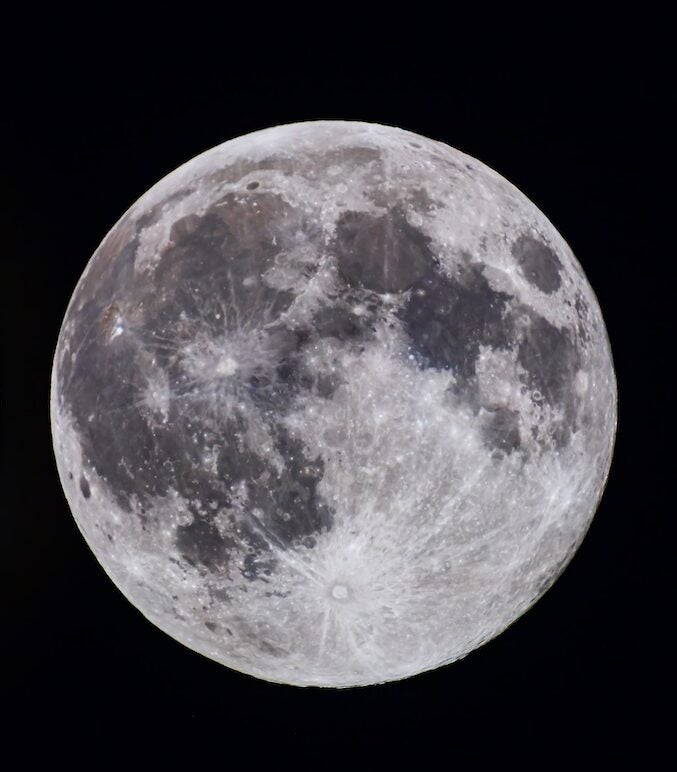 Research of soil samples retrieved through Apollo astronauts display that meteorite moves are in large part liable for freeing the atoms that shape the Moon’s skinny surroundings. Credit score: Alan Dyer
Research of soil samples retrieved through Apollo astronauts display that meteorite moves are in large part liable for freeing the atoms that shape the Moon’s skinny surroundings. Credit score: Alan Dyer
Earth’s moon is a light-weight. Whilst it looms huge in our skies, its gravity isn’t sturdy sufficient to carry onto a cumbersome surroundings. However it does retain a skinny blanket of atoms, referred to as an exosphere.
Planetary scientists know this exosphere is generated thru area weathering, as interactions between the Moon’s floor and incoming meteorites and photo voltaic radiation generate atoms to refill it. With out this, the exosphere would burn up as its atoms drifted out to area. However precisely which procedure — or aggregate of them — are maximum vital remained unknown, till researchers at MIT and the College of Chicago used soil accrued through Apollo astronauts to resolve ultimate yr that meteorites are the principle offender. Their paintings was once revealed Aug. 2 in Science Advances.
From 10 samples, they remoted two components — potassium and rubidium — to measure the isotopes of each and every within the soil. Isotopes of a given component include the similar choice of protons however a distinct choice of neutrons within the nucleus; isotopes with extra neutrons are heavier. The soil preferentially contained heavier isotopes, as anticipated. When meteorites or radiation slam into the lunar floor, it vaporizes bits of soil. Lighter isotopes must glide as much as create the exosphere, whilst heavier isotopes fall again to the bottom, however other area weathering processes go away other quantities of heavy isotopes. Evaluating the ratio of isotopes of potassium and rubidium within the soil held the important thing to how they have been launched.
“The reason why we look at the ratio instead of just one isotopic system is because it can help remove many complexities and isolate the effects of certain processes. Both rubidium and potassium are moderately volatile elements with similar geochemical behaviors, meaning they tend to respond similarly to many processes, like melting and vaporization. When we look at their isotopic ratio, we’re essentially filtering out the common effects of these processes that would affect both elements similarly,” says find out about lead writer Nicole Nie of MIT. Evaluating the weather way “we’re not trying to disentangle multiple effects on a single isotopic system. Instead, we can simplify the interpretation and get clearer insights into … space weathering processes,” she says.
The ratios display that have an effect on vaporization is developing the bulk — some 70 p.c — of the atoms within the Moon’s surroundings, whilst photo voltaic wind reactions are liable for the opposite 30 p.c.
The end result “is crucial for gaining insights into the space weathering processes that have shaped the lunar surface,” Nie says. “It enhances our understanding of planetary evolution. … These interactions are not unique to the Moon; they occur on other airless bodies like Mercury, asteroids, and moons of planets, so insights from the lunar exosphere can be applied to understanding surface processes across the solar system.”
6. Sgr A* can have a jet
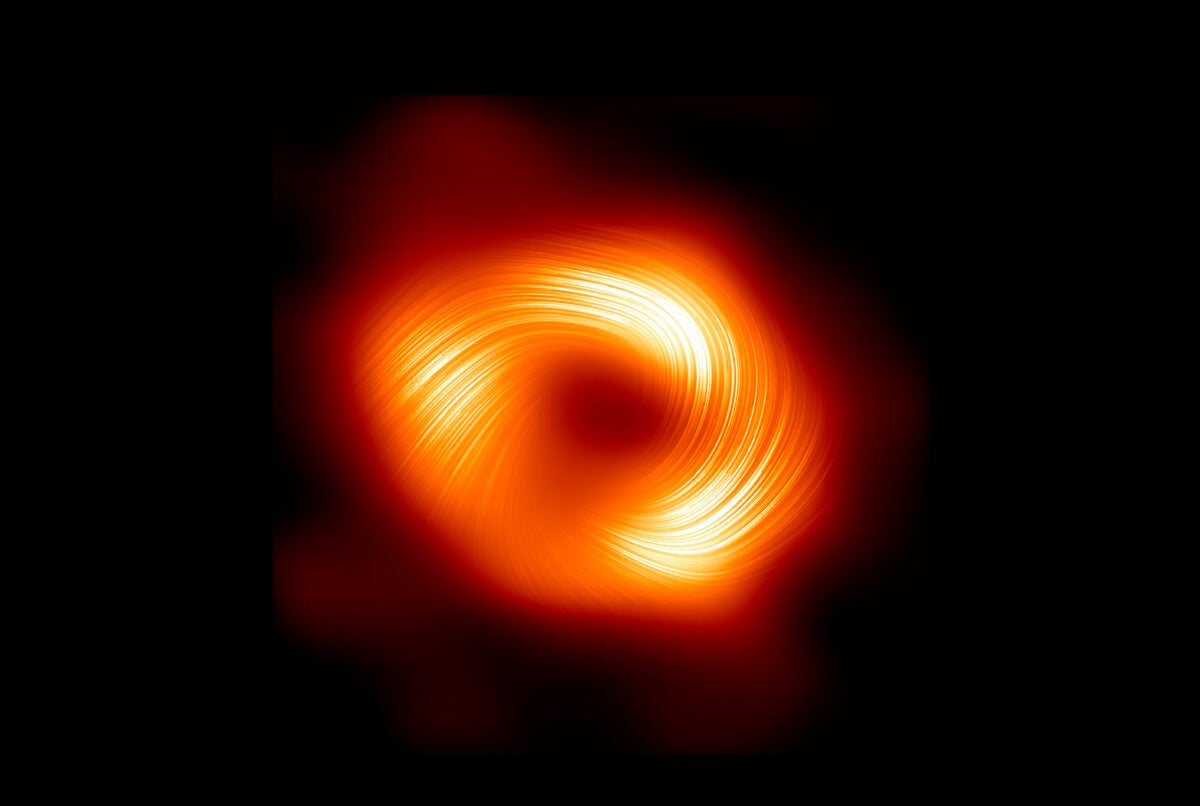 The Tournament Horizon Telescope produced this symbol of the Milky Method’s supermassive black hollow, Sgr A*, in polarized mild. The traces display the orientation of the polarization of the sunshine gained, which lines the black hollow’s magnetic box and displays a robust, ordered construction. Credit score: EHT Collaboration
The Tournament Horizon Telescope produced this symbol of the Milky Method’s supermassive black hollow, Sgr A*, in polarized mild. The traces display the orientation of the polarization of the sunshine gained, which lines the black hollow’s magnetic box and displays a robust, ordered construction. Credit score: EHT Collaboration
It’s been just about 3 years for the reason that Tournament Horizon Telescope (EHT) printed its symbol of Sagittarius A* (Sgr A), the Milky Method’s 4-million-solar-mass supermassive black hollow. However one image isn’t sufficient. Remaining yr, the EHT group launched a picture of Sgr A in polarized mild, along two papers revealed March 27 in The Astrophysical Magazine Letters.
Polarization refers back to the orientation of the electromagnetic waves that make up mild. When mild is polarized, its waves oscillate in combination in a most popular course. Inside a black hollow’s accretion disk of swirling, superheated plasma, magnetic box traces can align the transferring debris such that they emit polarized mild, necessarily stamping their emission with an afterimage of the embedded magnetic box. So, analyzing polarization unearths an image of the magnetic box across the black hollow.
In polarized mild, Sgr A* seems remarkably very similar to the opposite black hollow imaged this manner: M87* within the elliptical galaxy M87. That is even supposing Sgr A* is more or less one thousand occasions much less huge — and one thousand occasions smaller, with the plasma round it transferring a lot faster — than M87, hinting that sturdy, ordered magnetic fields may well be extra ubiquitous round supermassive black holes than prior to now idea. It additionally hints at one thing else that may well be extra common than astronomers idea: jets. Lots of the maximum huge black holes, together with M87, release far-reaching jets from their accretion disks, powered through magnetic fields. So, if Sgr A*’s magnetic box is so very similar to that of extra huge black holes, may it host a jet like they do as neatly?
No jet has ever been noticed blasting from our black hollow, however the seek is on. And the polarized mild symbol continues to be an impressive instrument, as small tweaks to fashion inputs can create large adjustments within the polarization produced, permitting researchers to higher perceive the prerequisites round our supermassive black hollow.
5. Eclipse ecstasy
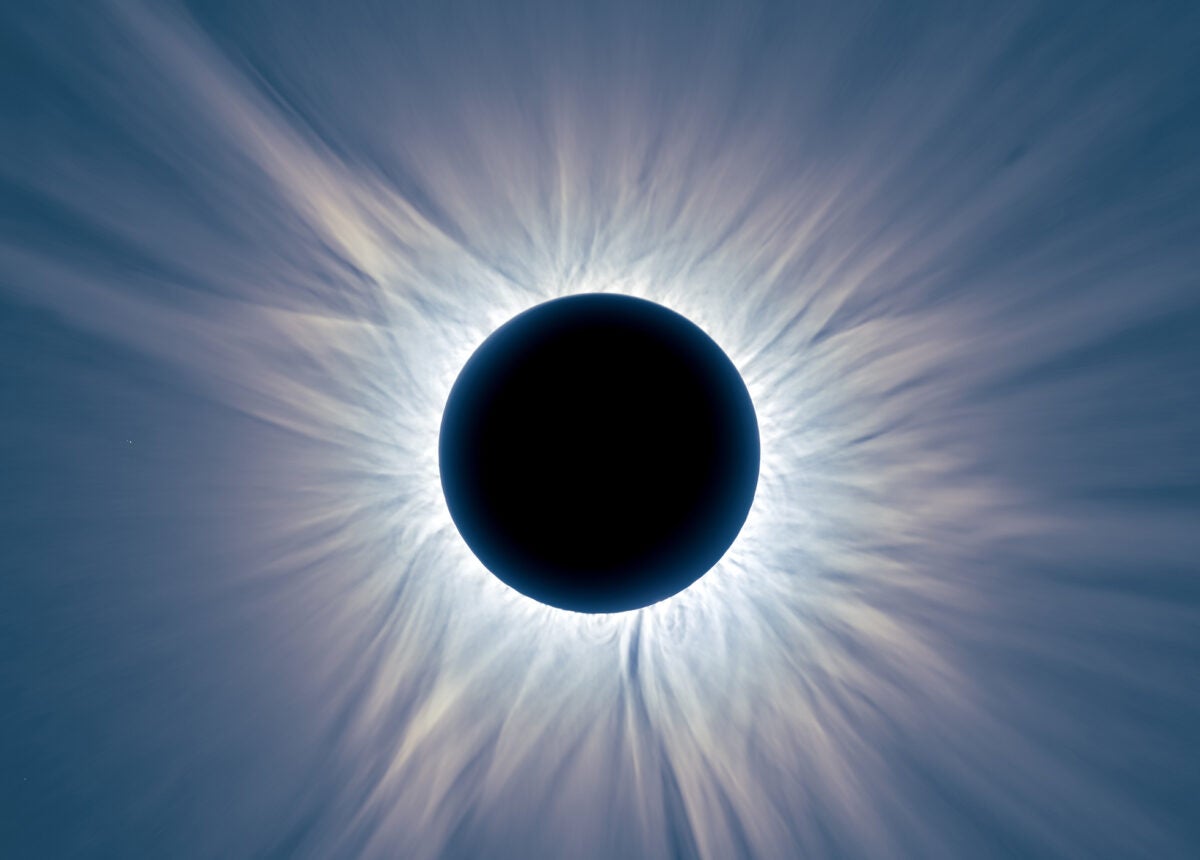 2024’s overall photo voltaic eclipse gave tens of millions a shocking view of an energetic Solar, with fantastic streams of plasma rising from the Solar’s floor. Credit score: Brent Bowen
2024’s overall photo voltaic eclipse gave tens of millions a shocking view of an energetic Solar, with fantastic streams of plasma rising from the Solar’s floor. Credit score: Brent Bowen
After years of anticipation and hype, the whole photo voltaic eclipse of April 8, 2024, made excellent on its guarantees, giving tens of tens of millions of audience a possibility to revel within the majesty of the Solar’s corona.
The eclipse was once nearly unquestionably the most-viewed within the historical past of the U.S. Seven years prior, the Nice American Eclipse of 2017 had minimize around the country from coast to coast, with 12 million other people residing within the trail of totality. In 2024, that quantity was once 31 million within the U.S., as the trail blanketed primary metro spaces from Texas to the jap seaboard. If truth be told, part all the U.S. inhabitants lived inside 250 miles of totality.
No longer best that, in 2024 Mexico and Canada joined the celebration. Making landfall in Mazatlán, the shadow of the Moon swept thru Durango and the Chihuahuan Barren region and on into Texas and the U.S. Midwest ahead of straddling the U.S.-Canadian border and departing the continent by means of Newfoundland.
Within the days main as much as the eclipse, forecasts of common clouds threatened to hose down the joy. At one level, forecast fashions predicted that many of the U.S. could be clouded out. However come eclipse day, the majority of the cloud quilt did not materialize, and maximum alongside the trail loved transparent skies — or excessive, skinny cloud layers that didn’t intrude with the Solar’s visible look.
Researchers took benefit of the eclipse, too. NASA awarded investment to 5 science tasks, together with chasing the eclipse with high-altitude analysis jets, radio-telescope observations of sunspot areas, and radar research of the consequences of the Solar’s shadow on Earth’s ionosphere. It turns available in the market continues to be quite a lot of alternative to find one thing new underneath the Solar and the Moon.
4. Starliner take a look at flight strands astronauts
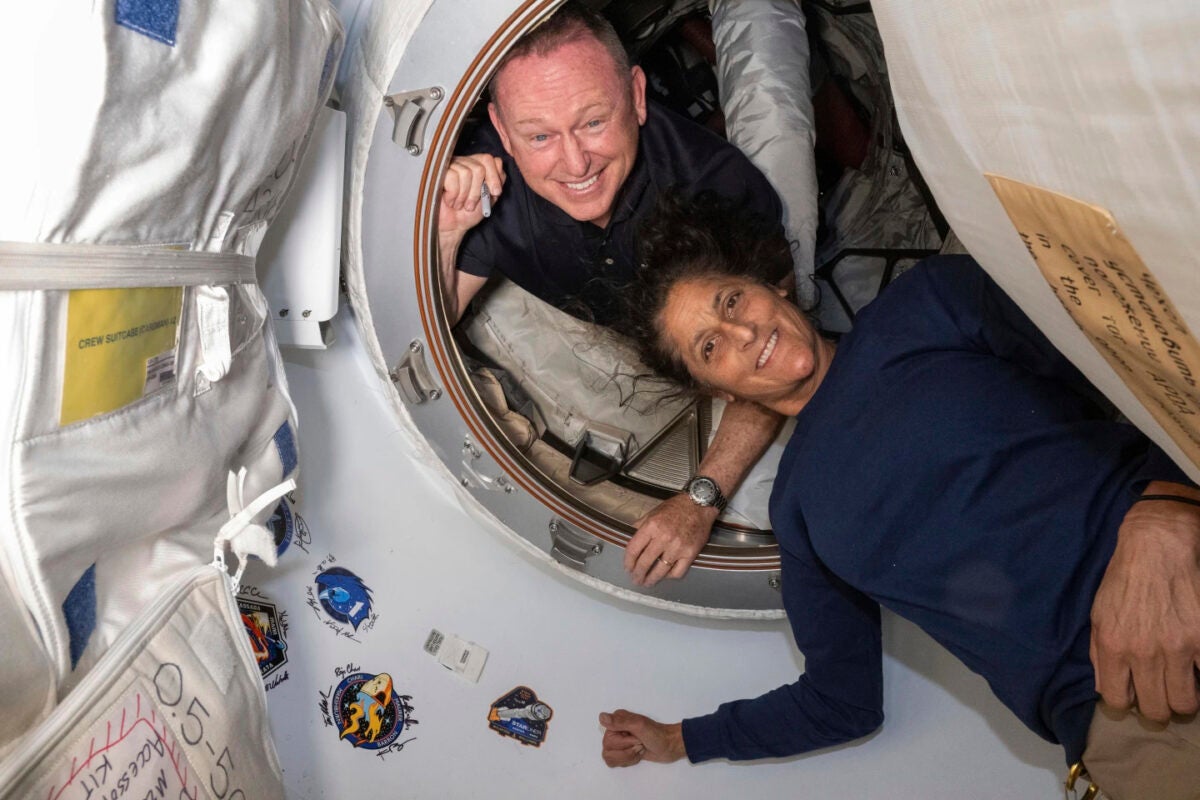 NASA astronauts Butch Wilmore (left) and Suni Williams deliberate on a weeklong consult with to the ISS, however ended up staying in area for 8 months as a extra everlasting a part of the group. Credit score: NASA
NASA astronauts Butch Wilmore (left) and Suni Williams deliberate on a weeklong consult with to the ISS, however ended up staying in area for 8 months as a extra everlasting a part of the group. Credit score: NASA
At 10:52 a.m. EDT on June 5, 2024, NASA astronauts Butch Wilmore and Suni Williams lifted off from Cape Canaveral, Florida, at the Boeing CST-100 Starliner pill’s long-awaited first crewed take a look at flight.
All over its adventure to the World House Station (ISS), alternatively, Starliner’s propulsion device evolved two helium leaks (along with one famous previous to release), in addition to problems with 5 of its 28 thrusters. Nevertheless, it effectively docked with the ISS and Wilmore and Williams ready to spend a couple of week in area ahead of piloting the craft again to Earth.
As a substitute, the empty Starliner touched down at White Sands House Harbor in New Mexico at 12:01 a.m. EDT on Sept. 7, whilst Wilmore and Williams remained in orbit for a complete of 8 months, to go back aboard a SpaceX Dragon pill in February 2025.
To start with, NASA merely not on time the astronauts’ go back, as the gap company and Boeing labored to resolve what had led to Starliner’s thrusters — important to each maneuver in area and to set the craft on a trajectory house — to malfunction. However on Aug. 24, NASA introduced it will deliver Starliner again uncrewed, as a substitute adjusting the SpaceX Team-9 challenge, which introduced Sept. 28, to go away two empty seats in its Team Dragon pill for Wilmore and Williams to go back house at that challenge’s finish.
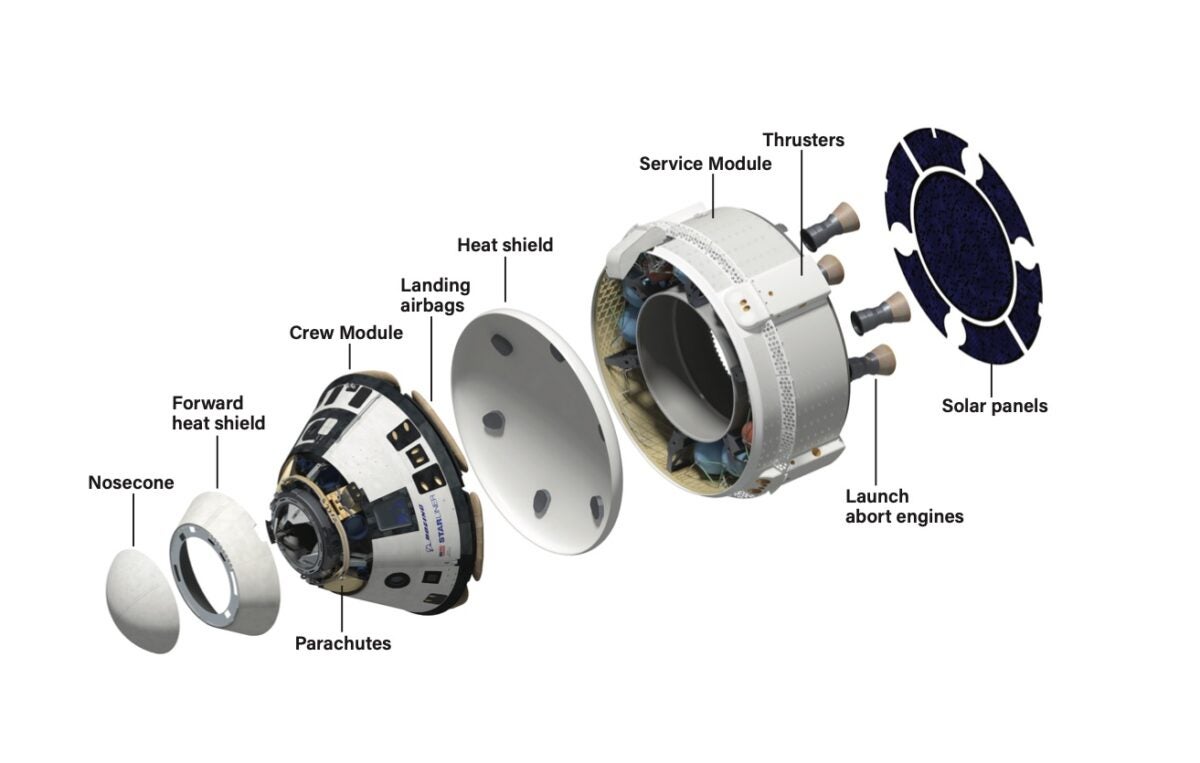 The Boeing Starliner is composed of a reusable Team Module and a single-use Carrier Module. The Carrier Module homes 28 thrusters, 5 of which malfunctioned all the way through the spacecraft’s first crewed take a look at flight ultimate yr. Additionally it is the portion of the craft that skilled 3 helium leaks. The 4 compartments housing the thrusters may no longer be accessed in area, nor may the misbehaving thrusters be tested at the flooring, because the Carrier Module is jettisoned all the way through reentry and burned up in Earth’s surroundings. Alternatively, the detailed records recorded all the way through the reentry process helps engineers resolve what led to the problem. Credit score: NASA
The Boeing Starliner is composed of a reusable Team Module and a single-use Carrier Module. The Carrier Module homes 28 thrusters, 5 of which malfunctioned all the way through the spacecraft’s first crewed take a look at flight ultimate yr. Additionally it is the portion of the craft that skilled 3 helium leaks. The 4 compartments housing the thrusters may no longer be accessed in area, nor may the misbehaving thrusters be tested at the flooring, because the Carrier Module is jettisoned all the way through reentry and burned up in Earth’s surroundings. Alternatively, the detailed records recorded all the way through the reentry process helps engineers resolve what led to the problem. Credit score: NASA
“When we looked at the data and looked at the potential for thruster failures [during undocking and deorbit] with a crew on board … it was just too much risk with the crew, and so we decided to pursue the uncrewed test flight,” stated Steve Stich, supervisor of NASA’s Business Team Program, all the way through a press convention to announce the verdict.
Wilmore and Williams, each veteran ISS occupants, took the additional time in area in stride. “That’s how things go in this business,” Williams stated in September from the station, emphasizing the unsure nature of take a look at flights. “This is my happy place. I love being up here in space,” she added.
On Sept. 6, Starliner left the ISS and finished all maneuvers by means of automation and with out factor, parachuting to a touchdown within the New Mexico barren region simply after nighttime native time. Its go back flight records went into the palms of engineers for meticulous analysis to resolve whether or not adjustments to the thrusters may well be vital ahead of it may be qualified for crewed missions.
“We knew going in this was going to be a test mission,” stated NASA Deputy Affiliate Administrator for House Operations Joel Mantalbano, following Starliner’s go back. “We learned a lot. … To me, [this was] a success. Clearly we [have] some work to do.”
3. Solar’s wrath thrills photo voltaic hurricane chasers
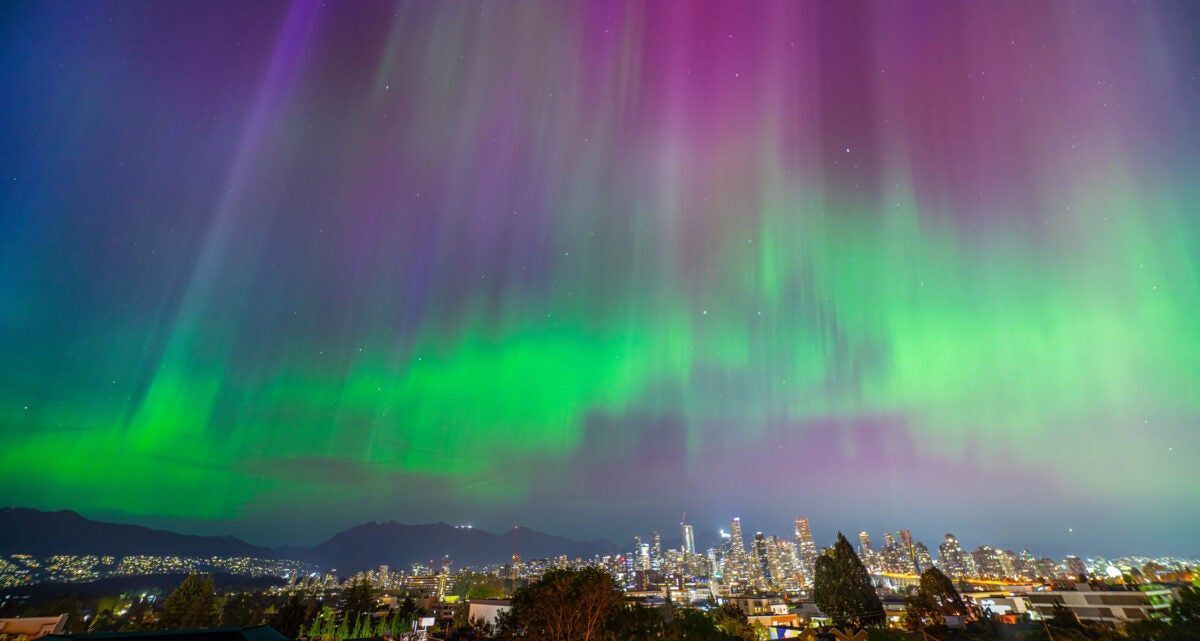 The convergence of part a dozen coronal mass ejections ended in a shocking show of aurora at the night time of Would possibly 10/11, together with on this symbol, over the intense town skyline of Vancouver. Credit score: Rob Lyons
The convergence of part a dozen coronal mass ejections ended in a shocking show of aurora at the night time of Would possibly 10/11, together with on this symbol, over the intense town skyline of Vancouver. Credit score: Rob Lyons
For fans of photo voltaic looking at, 2024 was once a yr of spoils. Along with April’s overall eclipse, the Solar reached the height of its 11-year cycle of process.
Since the Solar’s fuel rotates sooner at its equator than on the poles, our celebrity slowly winds itself up, its magnetic box traces twisting up like rubber bands. Each and every 11 years, they start to snap, freeing explosive bursts of calories.
In 2024, sungazers have been handled to dazzling presentations of sunspots, prominences, and flares. Those have been frequently accompanied through coronal mass ejections (CMEs) — storms of plasma that pace during the photo voltaic device. When a CME slams into Earth’s magnetic box, it might probably produce geomagnetic storms and powerful presentations of aurorae. And when the Solar spits out a number of in succession, they may be able to merge and strike with blended power.
In early Would possibly, a gargantuan sunspot staff, AR3664, unleashed part a dozen CMEs inside a couple of days, producing a really perfect hurricane that raced towards Earth at as much as 3 million mph (4.8 million km/h). In reaction, the House Climate Prediction Heart (SWPC) on the Nationwide Oceanic and Atmospheric Management issued a serious geomagnetic hurricane watch, caution energy firms to give protection to their grids and GPS customers to organize for doable disruptions. It was once the 1st G4-level watch — the second one very best point, in the back of G5 — in just about twenty years.
As night time fell throughout Europe on Would possibly 10, it temporarily changed into transparent that the hurricane was once exceeding expectancies. Social media was once flooded with footage of skies ablaze with good vegetables and magentas over Ecu towns and the snow-covered Alps.
At 6:54 p.m. EDT, SWPC reported the hurricane had hit G5 prerequisites. In North The united states, aurorae have been noticed in Cuba and Mexico. Globally, cameras captured aurorae as a ways south because the Hanle Darkish Sky Reserve in India, and as a ways north (within the Southern Hemisphere) as Namibia.
The ultimate geomagnetic hurricane of similar magnitude was once in 2003. However relating to the human enjoy, there was once no precedent. In 2003, the iPhone, Fb, and YouTube didn’t exist. With the development of sensor era, most of the people in the world elevate a digital camera of their pocket able to shooting aurorae and sharing it in an instant. Within the 7 million or so years since primates had been strolling upright throughout our planet and looking at up at sparkling curtains of sunshine within the night time sky, the Would possibly 2024 auroral hurricane was once a primary.
This thrills scientists, who now have a veritable treasure trove of citizen-science records to check. However it additionally made for an abnormal communal skywatching tournament, like a really perfect comet or overall eclipse, that can be remembered for many years to return.
2. Again to the Moon
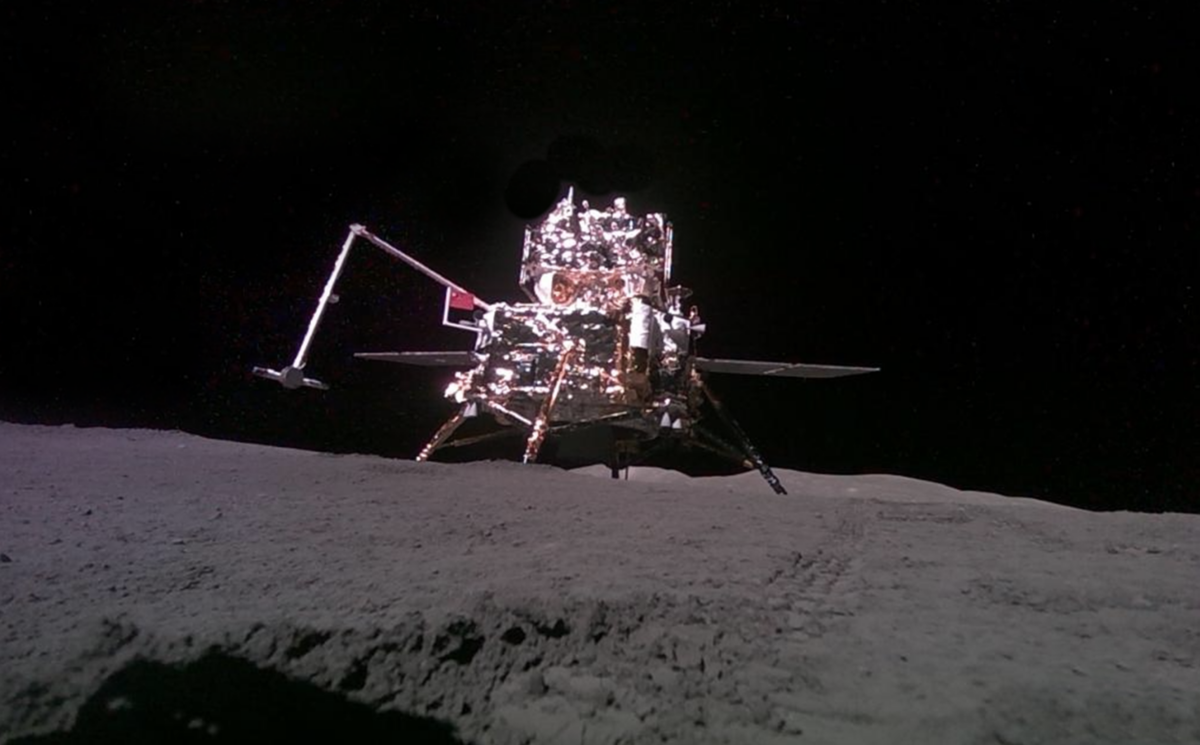 China’s Chang’e 6 returned the first-ever samples accrued from the Moon’s farside. Credit score: CNSA/handout by means of Xinhua
China’s Chang’e 6 returned the first-ever samples accrued from the Moon’s farside. Credit score: CNSA/handout by means of Xinhua
By no means thoughts the people. In 2024, a flotilla of robot explorers trekking to the Moon ushered in a brand new golden age of lunar exploration.The primary robot lunar landers, from the U.S. and previous USSR, touched down in 1966. 40-seven years handed ahead of China changed into the 3rd country to succeed in a cushy lunar touchdown, with 2013’s Chang’e 3. However a dizzying 10 months throughout 2023 and 2024 noticed two new international locations sign up for that unique membership, in addition to the 1st cushy lunar touchdown from a personal corporate, and likewise the 1st rocks returned from the Moon’s farside.
On Aug. 23, 2023, India made its first lunar touchdown with the Chandrayaan-3 challenge, depositing the Vikram lander and the Pragyan rover simply 390 miles (630 kilometers) from the Moon’s south pole. The craft and their suite of clinical tools operated for 12 Earth days, till the autumn of lunar night time, assembly their design lifespan.
Then 2024 kicked off with Japan’s Good Lander for Investigating Moon (SLIM) challenge, dubbed the “Moon Sniper” for its leading purpose: creating a precision touchdown inside 330 ft (100 meters) of its deliberate goal. The craft hit that mark on Jan. 19, despite the fact that it tipped over on touchdown, depriving its photo voltaic panels of energy. However 10 days later, because the Solar shifted within the Moon’s airless sky, it was once in a position to recharge and awaken, sending again records and pictures. Regardless that no longer designed to live to tell the tale the lunar night time — which lasts 14 Earth days — the craft abruptly survived 3 of them, making its ultimate touch in April.
Some other primary milestone arrived Feb. 14, when the Houston-based corporate Intuitive Machines changed into the 1st corporate to make a cushy lunar touchdown with its Odysseus lander. It completed this regardless of a wiring error that disabled its laser rangefinders. Odysseus skidded laborious on touchdown, breaking a leg and coming to leisure at a tilt. Nonetheless, like SLIM, it was once a ancient milestone, despite the fact that the orientation of the craft restricted operations for one of the crucial six clinical experiments that it carried for NASA. (The challenge was once funded through NASA as a part of its Business Lunar Payload Services and products program.)
Then, on June 1, China scored its newest success — gathering the first-ever samples from the Moon’s farside, with its Chang’e 6 challenge. The challenge was once in keeping with the Chang’e 5 structure, however China’s supply of a Moon-orbiting relay satellite tv for pc allowed it to keep up a correspondence because it landed at the farside within the South Pole-Aitken have an effect on basin, accrued samples, and flew them again to a ready orbiter and go back craft. Researchers hope the samples will make clear why the rugged farside is so other from the lava-plain-covered nearside.
This new wave of lunar missions is already yielding clinical effects. Preliminary research of Pragyan records revealed in Nature Aug. 21, 2024, printed that the composition of rocks at its touchdown web page is similar to samples returned from the Apollo 16 and Luna 20 websites, over 1,000 miles (1,600 km) north. This strengthens the case that those rocks have been as soon as a part of a world ocean of magma that lined the Moon’s floor quickly after its formation.
And scientists are nonetheless gleaning knowledge from the samples returned through the 2020 Chang’e 5 challenge. A find out about revealed Sept. 6 in Science from a Chinese language group discovered glass beads that counsel the Moon was once volcanically energetic simply 125 million years in the past, when dinosaurs nonetheless roamed Earth, opposite to the normal knowledge that its volcanoes had been silent for one billion years.
1. JWST makes extra discoveries — and gives some solutions
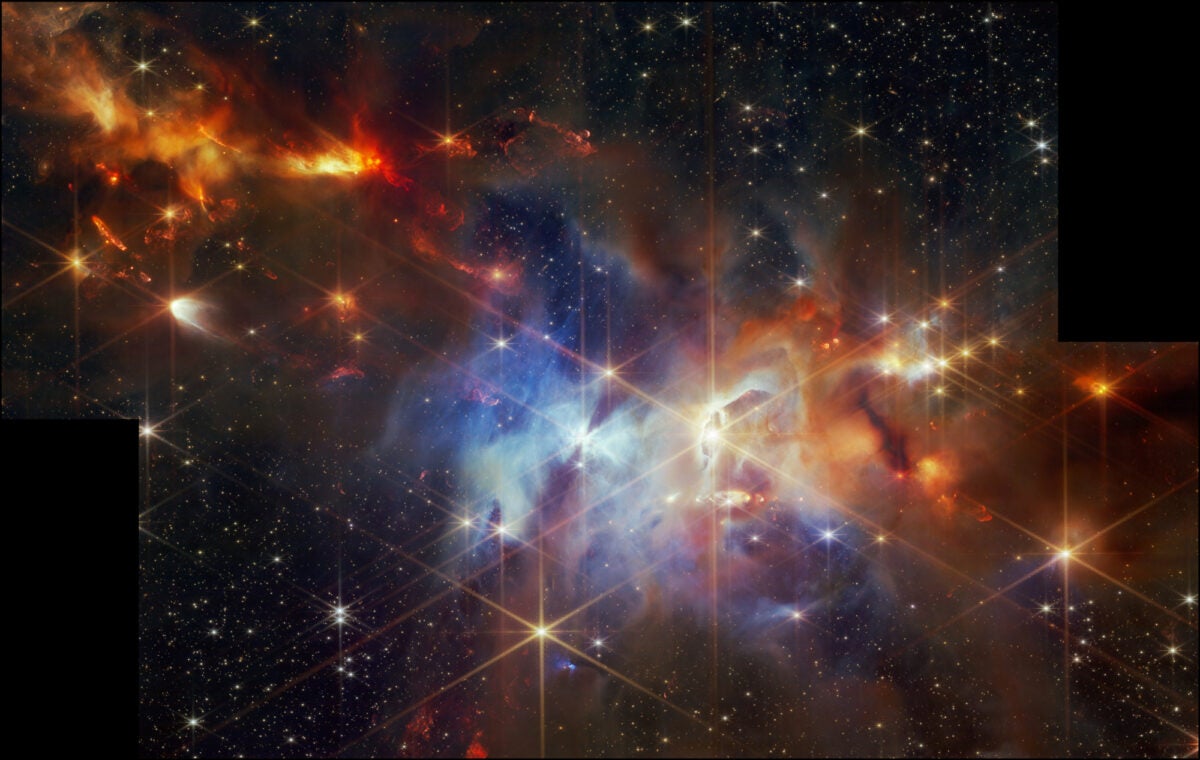 On this surprising NIRCam symbol of the Serpens Nebula, JWST printed a number of protostars (at higher left) with jets that aligned no longer best with each and every different, however with the filament of the molecular cloud from which they’d shaped. Credit score: NASA, ESA, CSA, Ok. Pontoppidan (NASA’s Jet Propulsion Laboratory) and J. Inexperienced (House Telescope Science Institute)
On this surprising NIRCam symbol of the Serpens Nebula, JWST printed a number of protostars (at higher left) with jets that aligned no longer best with each and every different, however with the filament of the molecular cloud from which they’d shaped. Credit score: NASA, ESA, CSA, Ok. Pontoppidan (NASA’s Jet Propulsion Laboratory) and J. Inexperienced (House Telescope Science Institute)
Unsurprisingly, the james webb area telescope (Jwst) makes our listing all over again. Even though it made too many discoveries to say all of them, we’re highlighting a couple of 2024 reveals throughout a variety of fields, from planets and stars to one of the crucial largest questions in regards to the cosmos’ early historical past.
In a Feb. 22 Science paper, JWST supplied the most productive proof but for the neutron celebrity astronomers consider was once left in the back of through the supernova SN 1987A within the Massive Magellanic Cloud. The infrared scope noticed the glow of ionized fuel whose atoms — referred to as ions — have had a number of electrons knocked off through high-energy photons. “To create these ions that we observed in the ejecta, it was clear that there had to be a source of high-energy radiation in the center of the SN 1987A remnant,” stated lead writer Claes Fransson of Stockholm College in a press free up. “Only a few scenarios are likely, and all of these involve a newly born neutron star.”
In April, JWST confirmed off its exoplanet science chops after looking at starlight filtering during the surroundings of the fuel large WASP-43 b. Via combining details about the molecules the telescope noticed with three-D local weather fashions, researchers have been in a position to map the planet’s climate from 280 light-years away: a cloudy nightside, a transparent dayside, and winds on the equator achieving some 5,000 mph (8,050 km/h).
A June free up highlighted every other JWST first: The invention of aligned jets from a gaggle of forming stars. Astronomers had lengthy suspected that stars born from the similar molecular cloud must rotate in the similar course, imparted through the cloud’s movement. However they’d by no means noticed such alignment till JWST’s sharp eye stuck some 20 protostars within the Serpens Nebula, with jets all aligned inside 24° of the axis of the filament that had shaped them.
And in the event you recall ultimate yr’s listing, it’s possible you’ll bear in mind the possibly “universe-breaking” galaxies JWST became up not up to one billion years after the Giant Bang: six galaxies shining so brightly that astronomers suspected they contained as much as 100 billion photo voltaic plenty’ value of stars each and every. Galaxies so huge must no longer shape so temporarily, prompting issues about our figuring out of ways early subject assembled.
Since then, researchers had been running to give an explanation for the discovering. In an August paper revealed in The Astronomical Magazine, a group the use of records from JWST’s Cosmic Evolution Early Liberate Science survey confirmed that the galaxies have customary plenty and are as a substitute getting a brightness spice up from the accretion disks round their central supermassive black holes. New JWST observations confirmed the signature of sizzling, fast-moving fuel in those galaxies — a trademark of the accretion disk round a black hollow.
“The bottom line is there is no crisis in terms of the standard model of cosmology,” stated find out about co-author Steven Finkelstein, a professor of astronomy on the College of Texas at Austin.
Even though the galaxies didn’t develop sooner than anticipated, “we are still seeing more galaxies than predicted” at this early time through more or less an element of 2, stated lead writer Katherine Chworowsky, additionally of UT Austin. Astronomers wonder whether this abnormal end result may well be as a result of early stars nonetheless shaped moderately temporarily, extra simply assembling into galaxies.
So, whilst one thriller is solved, every other has popped up. Keep tuned — possibly subsequent yr JWST will shed much more mild in this new cosmic conundrum.
Price range shortfalls threaten NASA’s long run
Value-cutting took a toll on different NASA missions in 2024.
On July 17, NASA shocked the clinical neighborhood through cancelling the challenge of a $450 million Moon rover that had already been constructed. The Volatiles Investigating Polar Exploration Rover (VIPER) was once supposed to seek for water ice close to the lunar south pole in preparation for long run Artemis crews that would possibly absorb place of abode within the neighborhood. It best had to move environmental checking out and be loaded onto its rocket for a 2025 release. Taking a look to chop prices, NASA introduced to offer the rover away, without cost, to any corporate or group that was once keen to endure the price of flying it to the Moon and wearing out its authentic challenge.
In the meantime, the Chandra X-ray telescope spent 2024 celebrating 25 wildly productive years of observations whilst concurrently being ended in the guillotine. Whilst nonetheless totally purposeful because the highest-resolution X-ray telescope within the sky, in March, NASA stated it will lay off maximum of its group of workers later within the yr. NASA additionally indicated in its 2025 funds request that it deliberate to attract the challenge right down to “minimal operations” — a prelude to shuttering the scope for excellent. Scientists replied with an abnormal outcry and several other participants of Congress joined them, main NASA to announce Oct. 23 that it will keep the observatory’s execution till Congress appropriates budget for 2025.
Those problems are signs of a broader malaise at NASA, which was once laid naked in a complete record titled NASA at a Crossroads launched September 11 through the Nationwide Academies of Sciences, Engineering, and Drugs (NASEM). The frame may be liable for the influential astronomy and planetary science decadal critiques, which information Congress, NASA, and different investment businesses in deciding which tasks to prioritize.
The crux of NASA’s problems is that the company’s buying energy has remained necessarily flat over the last 20 years, but it’s directed to tackle extra tasks than ever. This push for extra missions comes on the expense of keeping up NASA’s present sources and infrastructure. The NASEM record said that “during its inspection tours, the committee saw some of the worst facilities many of its members have ever seen.” The record singled out the Deep House Community — NASA’s world community of radio dishes liable for speaking with the whole thing from JWST to the Voyager probes — as in particular stretched and in dire want of upgrades.
The record additionally criticized NASA’s personal loss of long-term strategic making plans, in particular within the Artemis program. And the committee warned that depending at the industrial sector to broaden and perform its missions risked NASA morphing into a trifling contract observe and dropping its body of workers to extra inspiring organizations and corporations.
Tales to wait for in 2025
NASA’s Lucy challenge to discover Jupiter’s Trojan asteroids will fly through the carbonaceous main-belt international 52246 Donaldjohanson on April 20, whilst on its approach to the fuel large.
The Vera C. Rubin Observatory in Chile is scheduled to peer daybreak Would possibly 16, 2025. The observatory will then go through a overview for operations readinessin mid-August.
NASA’s bold Artemis II challenge, which can ship 4 astronauts on a 10-day adventure across the Moon, is focused on a release no previous than September 2025.
NASA’s Business Lunar Payload Services and products initiative has 3 launches deliberate for 2025. Griffin Venture 1 will take a look at Astrobotic’s lander (sans the canceled VIPER rover); Lunar Pathfinder will position an orbiter across the Moon; and Intuitive Machines 3 will shipping a number of payloads, together with a data-relay satellite tv for pc and a rover.
